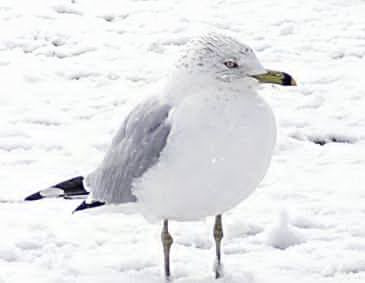A seagull does not freeze even while standing on ice with bare feet. How does this creature conserve its body heat? Part of the secret is in what are called countercurrent heat exchangers.
A countercurrent heat exchanger consists of a tube carrying a warm fluid that runs in close proximity to a tube carrying a cool fluid. If the fluids run in the same direction, only half of the heat is transmitted, at best. But if the fluids run in opposite directions, nearly 100 percent of the heat is transmitted.
The heat exchangers in a seagull’s legs cool the blood on its way to the feet to near freezing and then rewarm the blood as it returns. Concerning birds in cold environments, ornithologist Gary Ritchison writes: “The principle of countercurrent heat exchange is so effective and ingenious that it has also been adapted in human engineering projects to avoid energy waste.”
skip to main |
skip to sidebar
ADVERTISEMENTS
Archives
-
▼
2010
(45)
-
▼
September
(20)
- Why Men Die Younger
- Good Music Can Be Good Medicine
- Oxygen-Starved Eyes
- Know Your Hair
- The World’s Largest Seed
- “Talking” Plants
- The Power of a Smile
- Strange New Organism Discovered
- First Light Pollution Law
- Carbon Monoxide — The Silent Killer
- Timepiece - The Science Behind the Machine
- The World’s First Photographer
- Deafness From Headsets
- Longevity, Is the Secret in Okinawa?
- First Aid at Funerals
- The Seagull’s Leg
- Robots, How Far Have They Come?
- Long Lived Whale
- Less Sleep, More Colds
- Paper as Strong as Iron
-
▼
September
(20)
Copyright ©2011. Powered by Blogger.
Popular Posts
-
Dandelions “are reviled as Public Enemy No. One by golf course superintendents and fastidious lawn owners everywhere” and as “the weed that ...
-
Memory involves three stages: encoding, storage, and retrieval. Your brain encodes information when it perceives it and registers it. This i...
-
KING Ferdinand I (1751–1825) is said to have disguised himself as a commoner and, in clandestine fashion, visited a poor neighborhood in Nap...
-
Narcolepsy is an illness that causes its victims to have frequent attacks of sleepiness. Explains sleep researcher Wilse B. Webb: “People wi...
-
Although it lasts only a moment, the memory may stay with you all your life. Its value is immense, but nobody is so poor that he cannot shar...
-
WHAT is stress? According to one expert, stress may be defined as “any physical, chemical, or emotional factor that causes bodily or mental ...
-
Many years ago, when an unusually large seed washed ashore on islands of the Maldives and Indonesia, it captured the human imagination. Myth...
-
Researchers at the Swedish Royal Institute of Technology have developed a method of producing paper from wood cellulose that preserves the n...
-
“An influx of cheap electronic goods” might put British burglars out of their jobs, according to a Reuters news report from London, quoting ...
-
Imagine a product that can be used as medicine, a cleaning agent, a disinfectant, and a beauty treatment . You can eat it, drink its juic...
Copyright © 2011 Do You Know? | Powered by Blogger
Design by Free WordPress Themes | Bloggerized by Lasantha - Premium Blogger Themes | Best Buy Coupons


 10:57 PM
10:57 PM
 Hmm
Hmm



 Posted in:
Posted in: 









0 comments:
Post a Comment